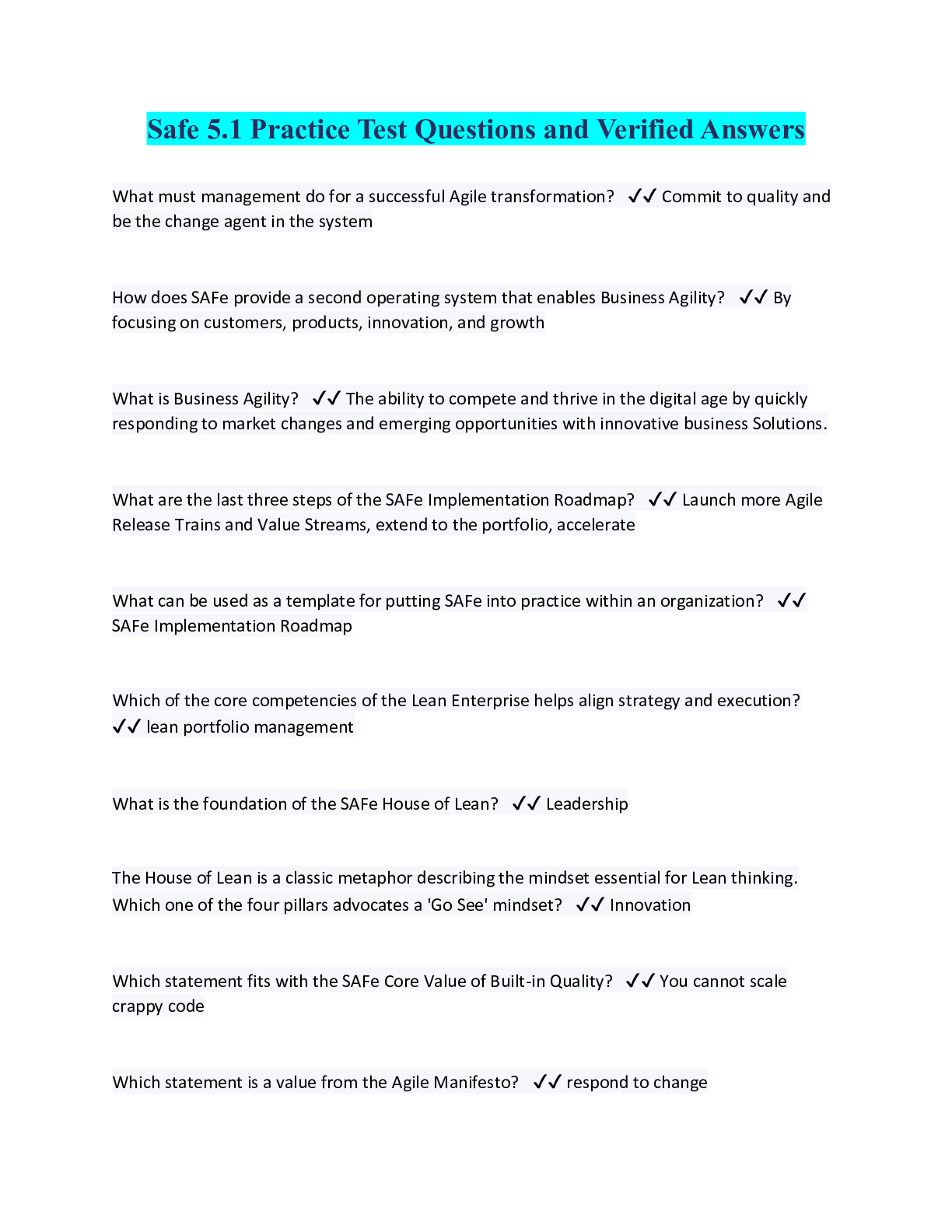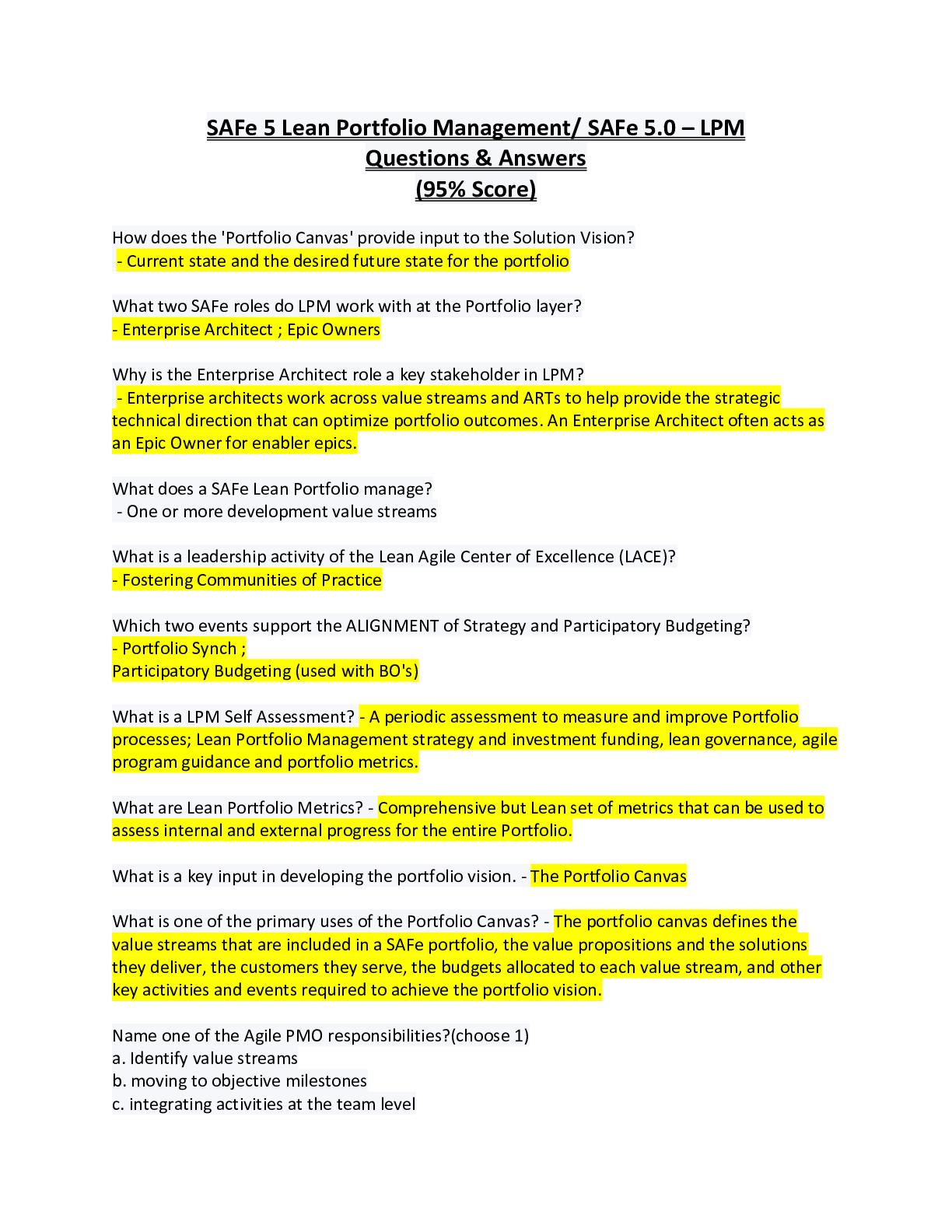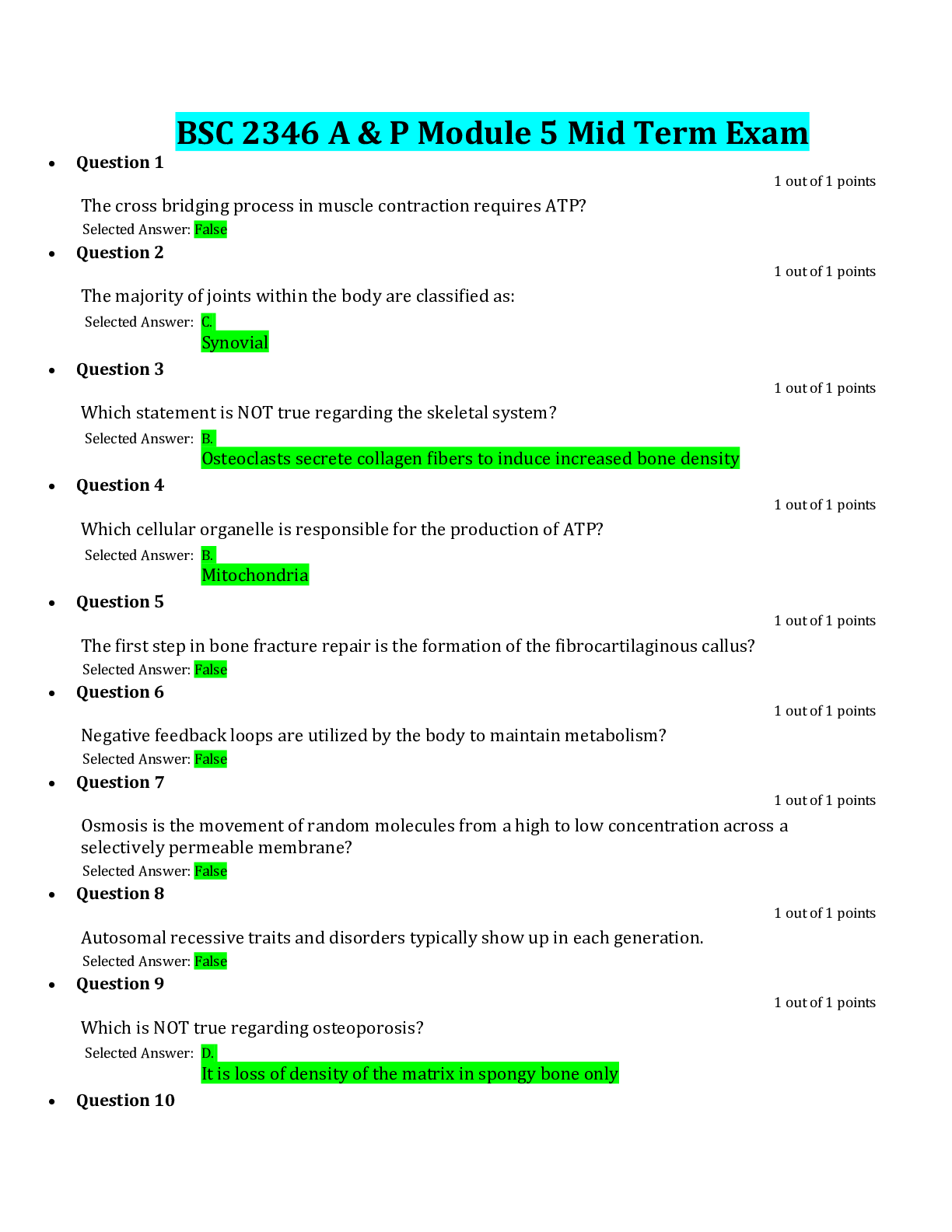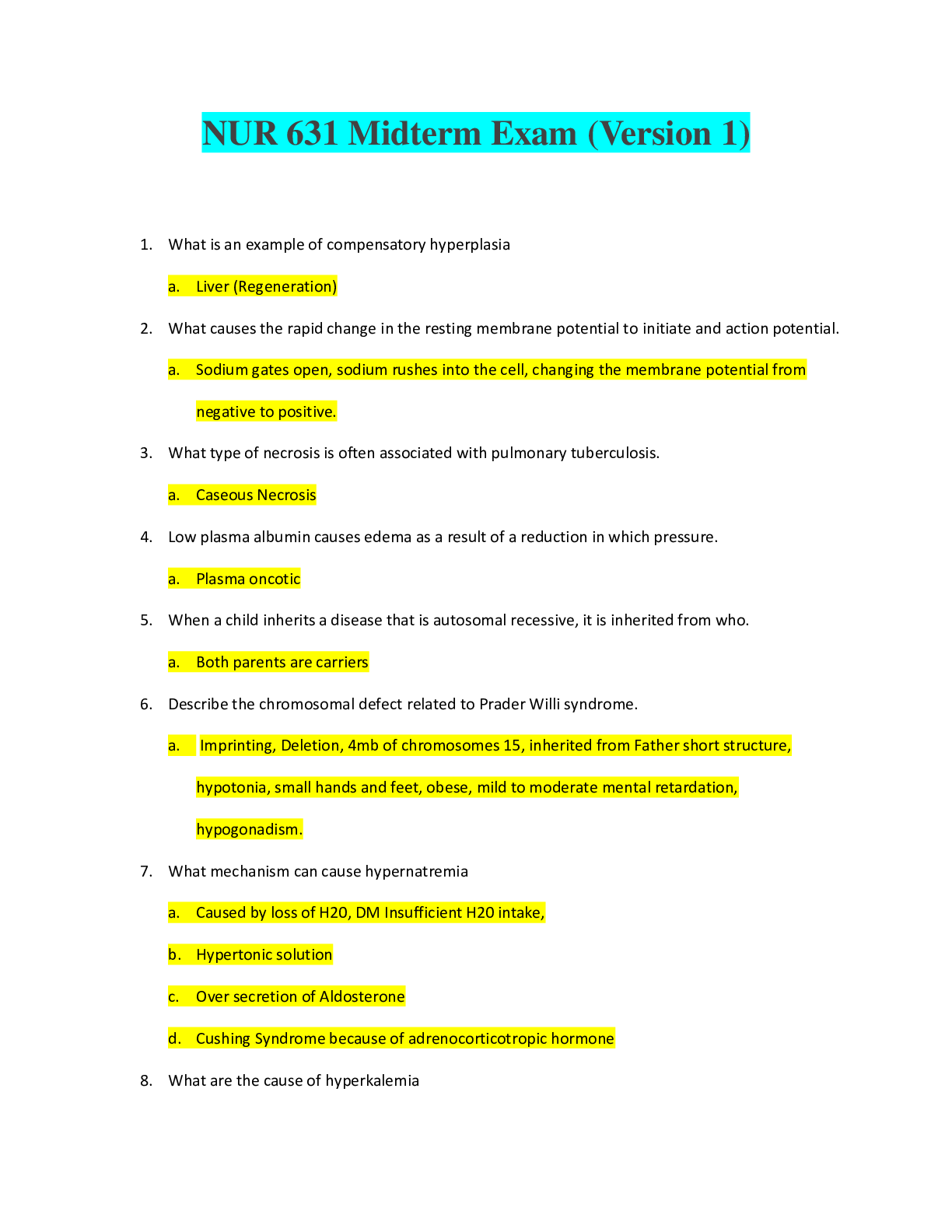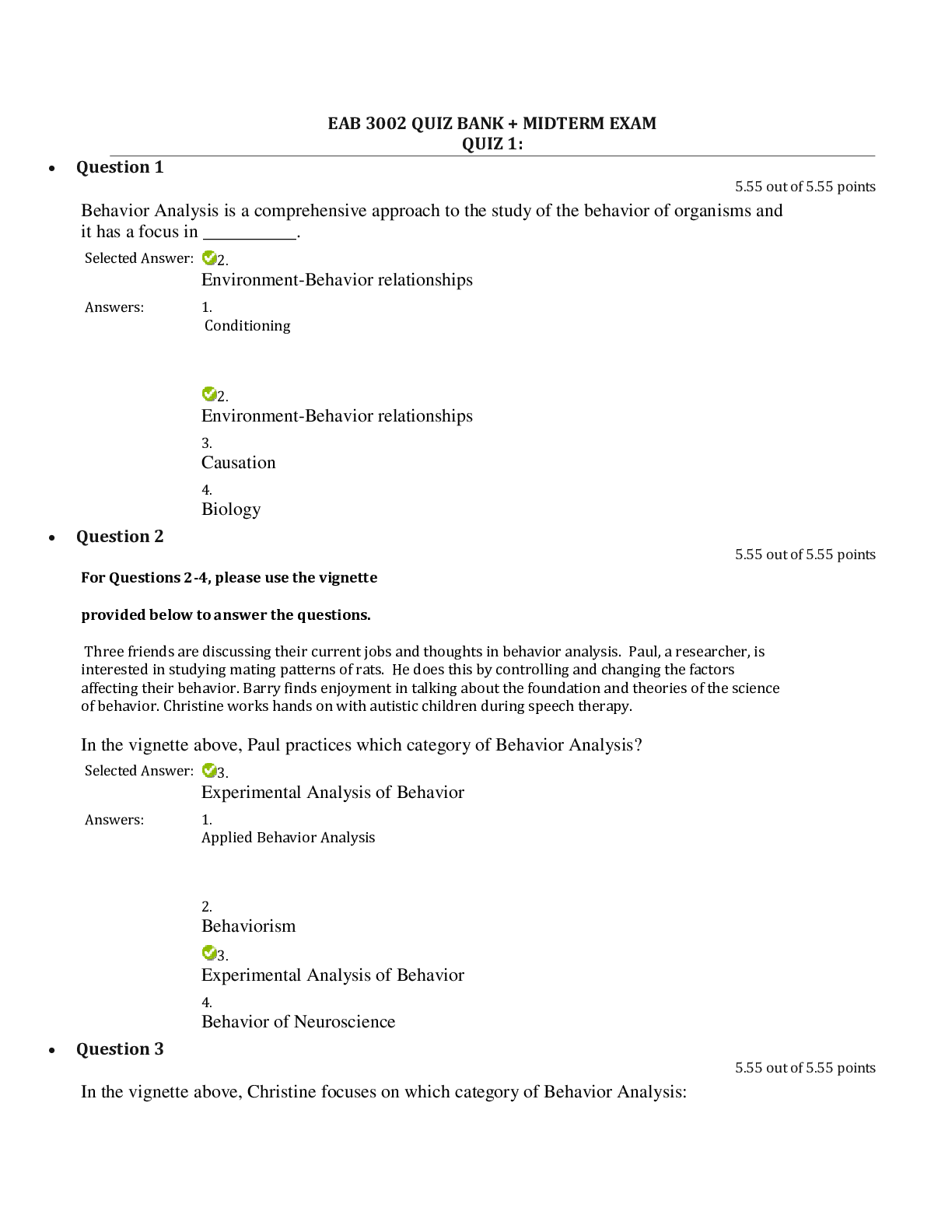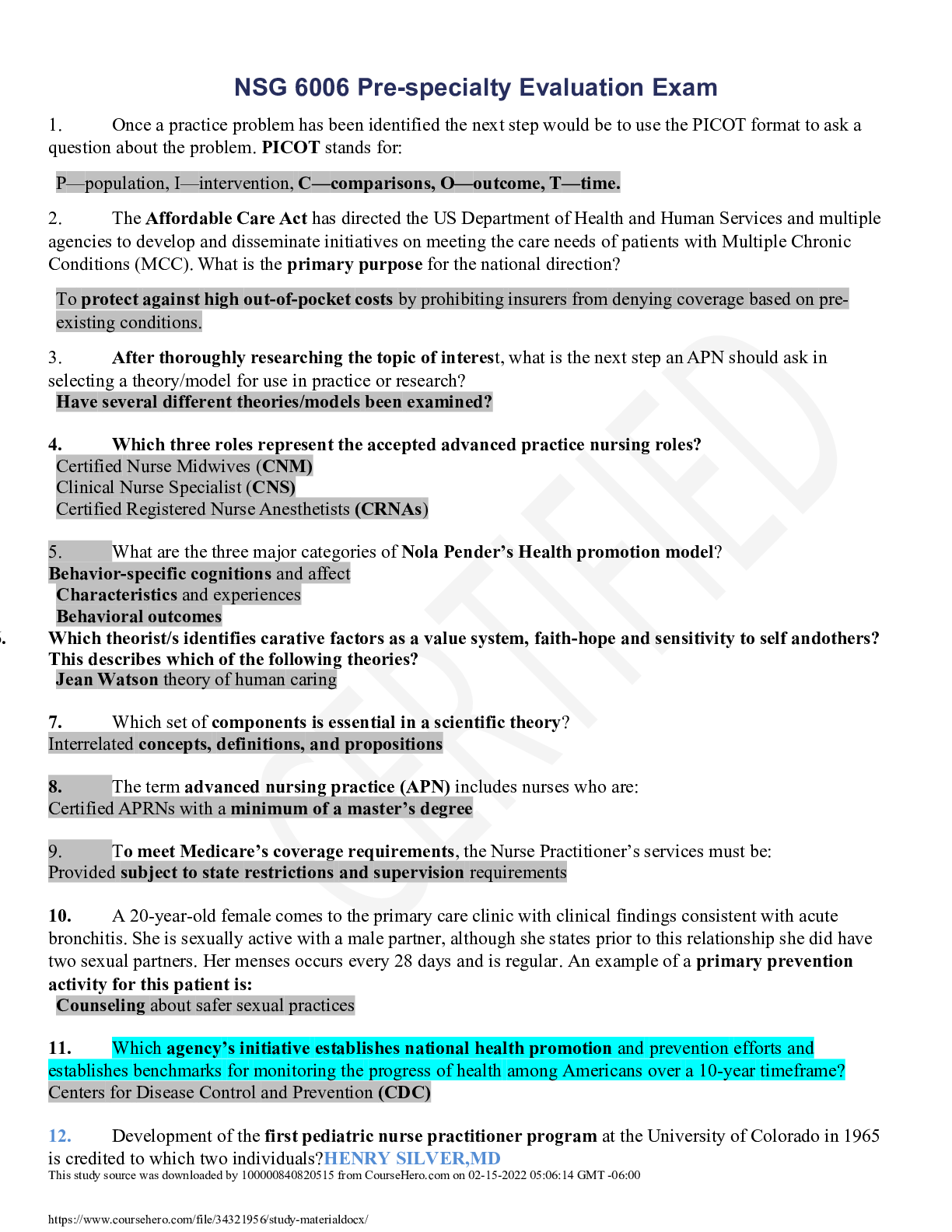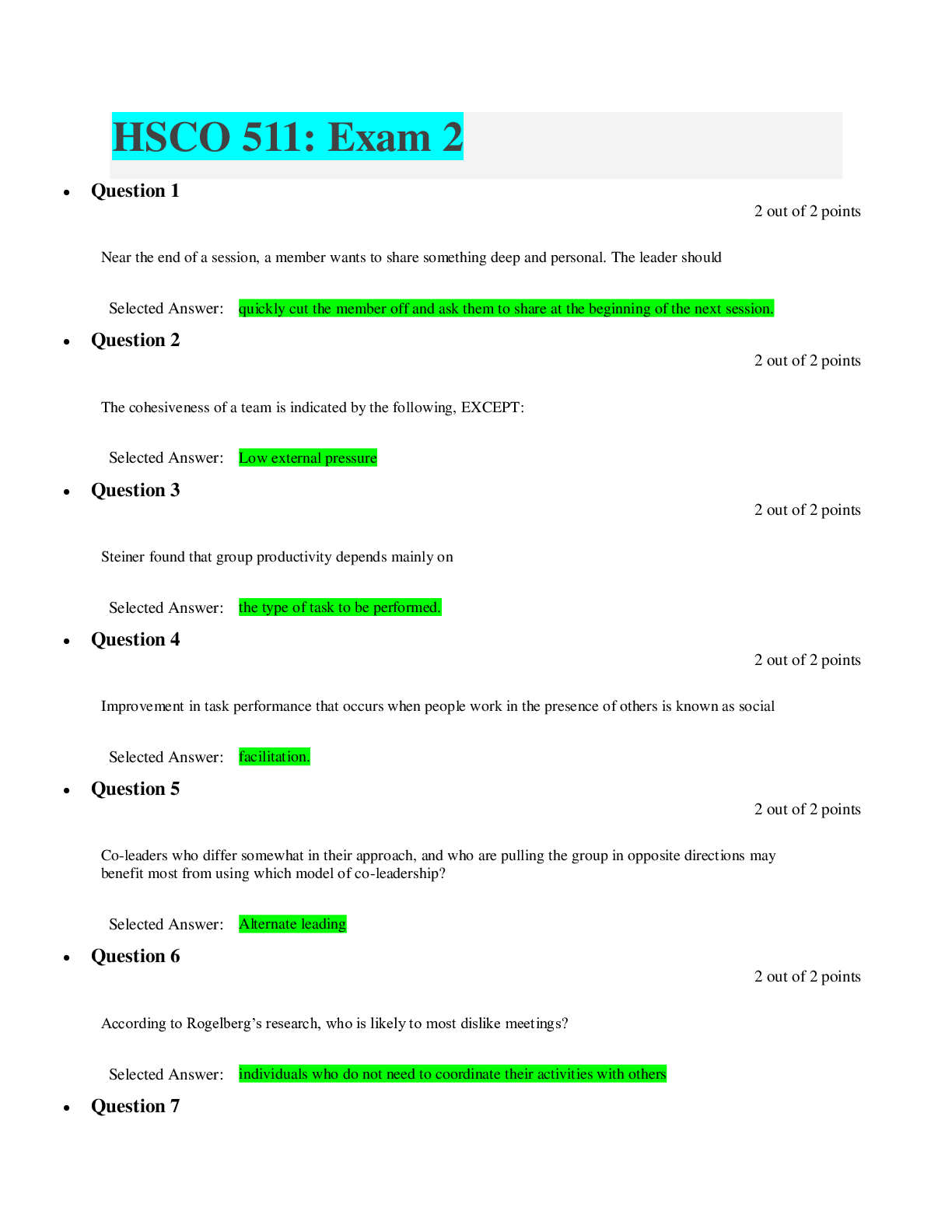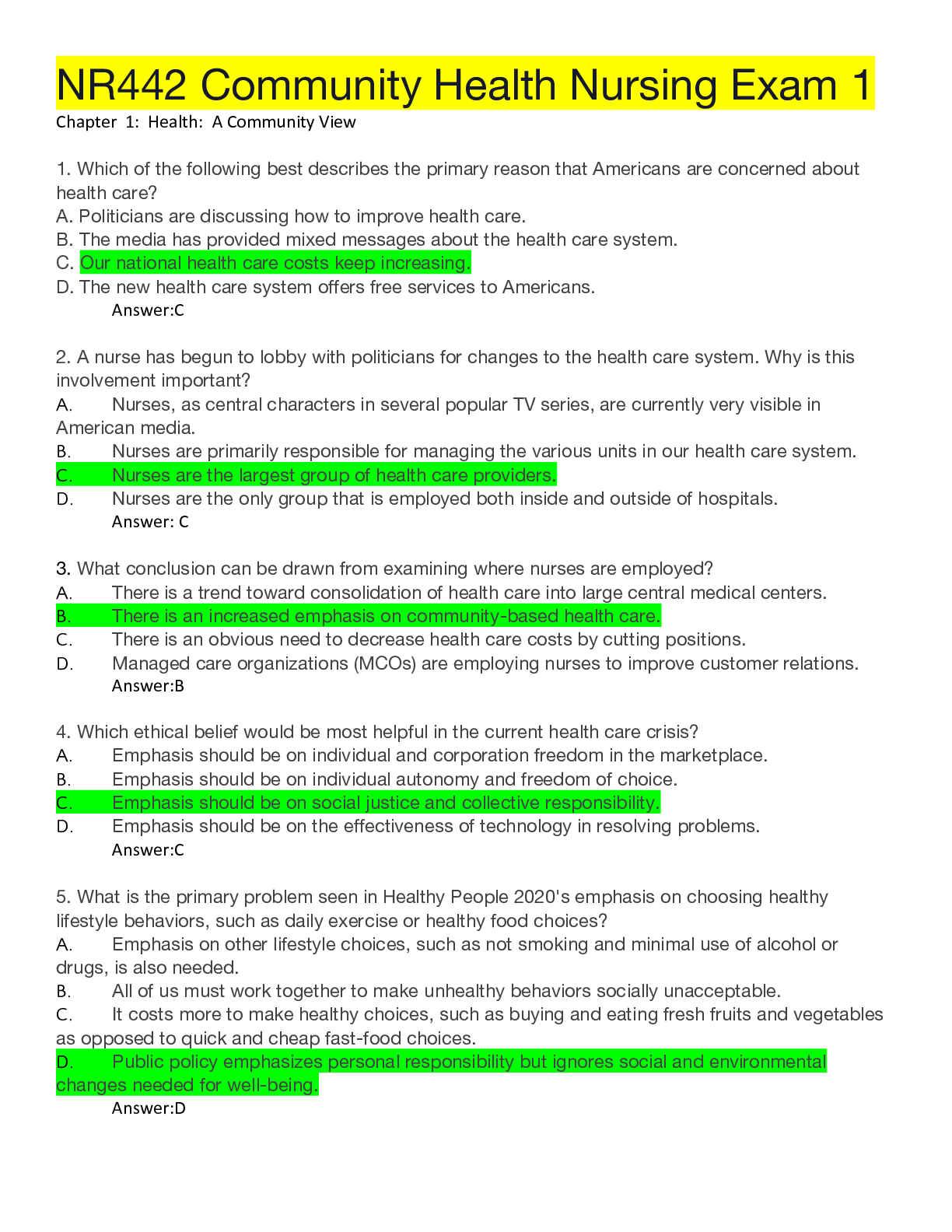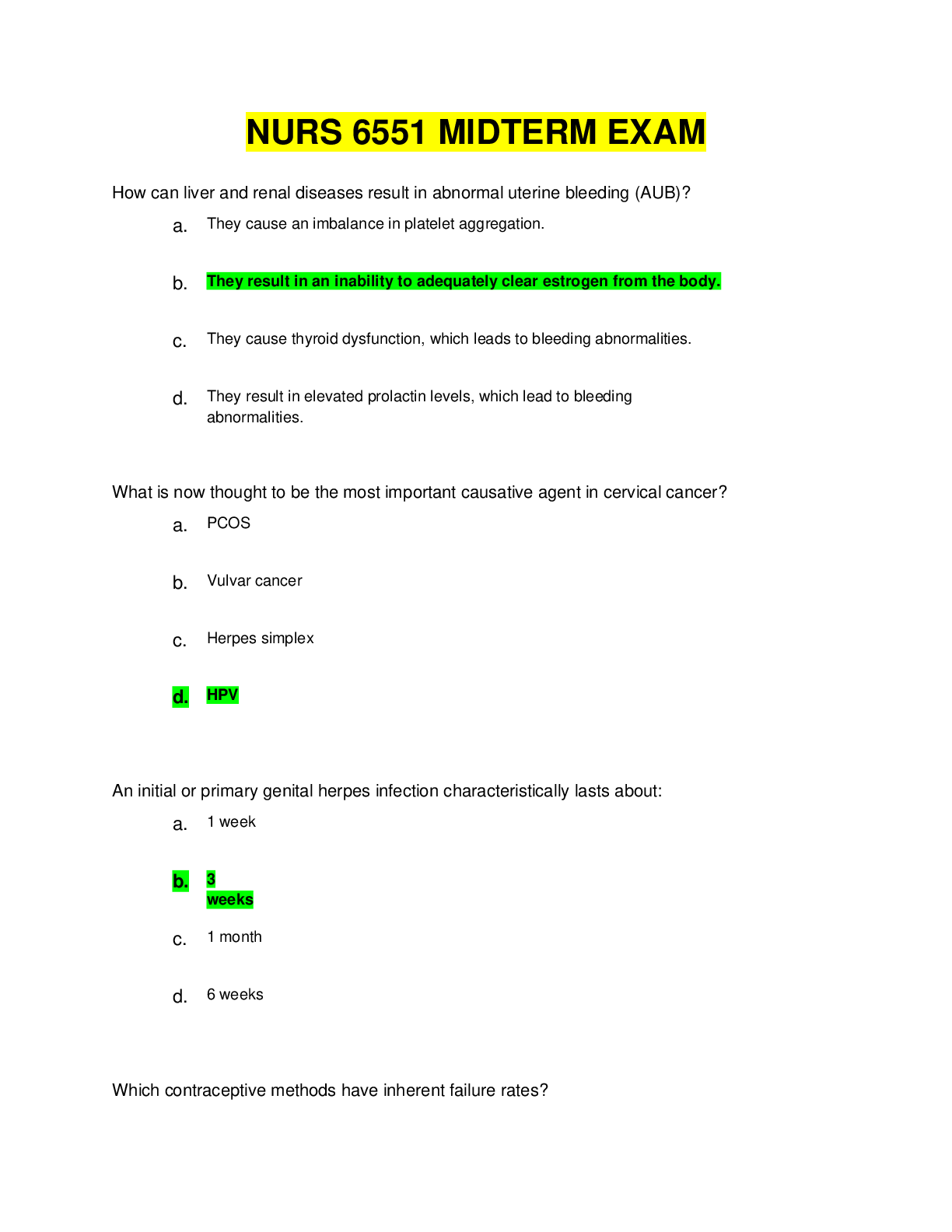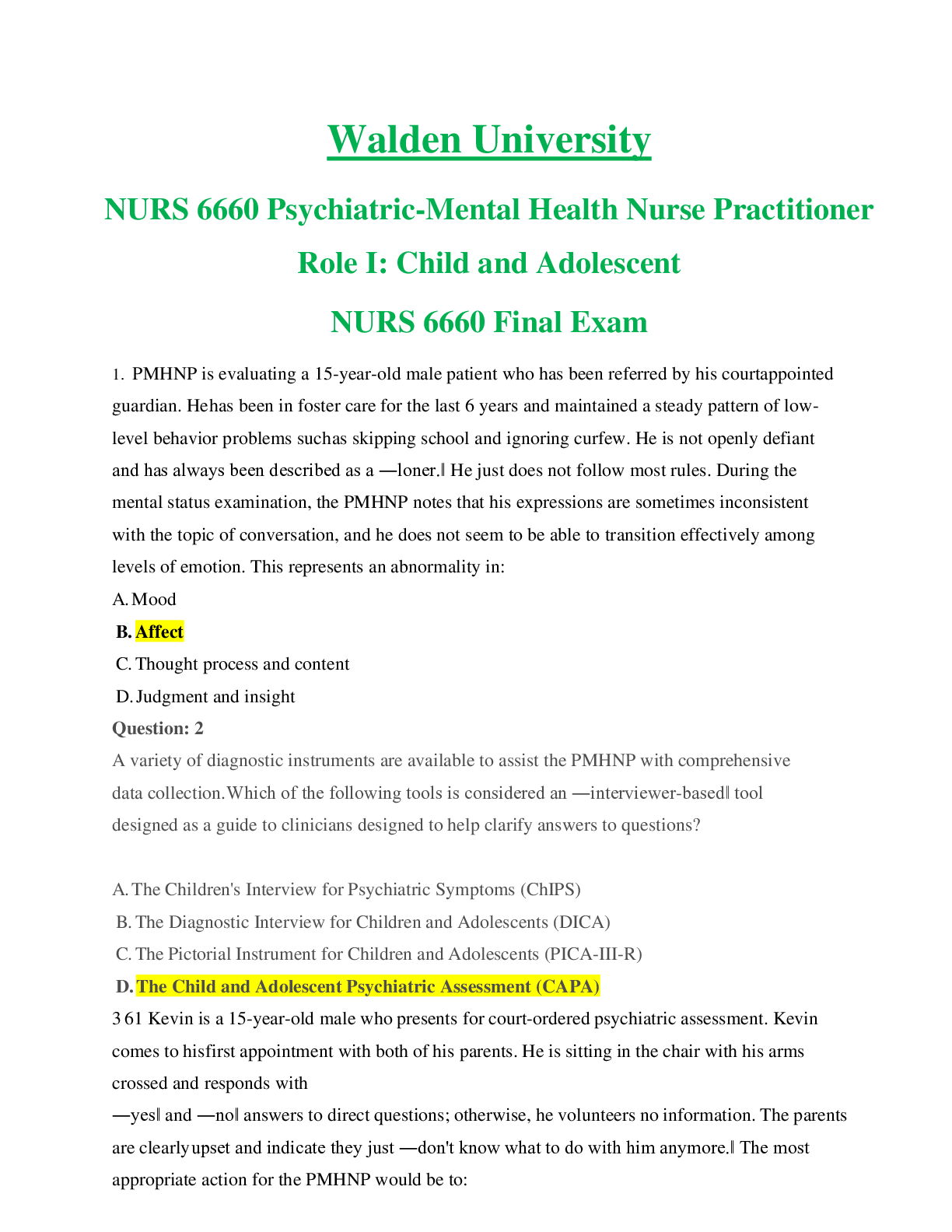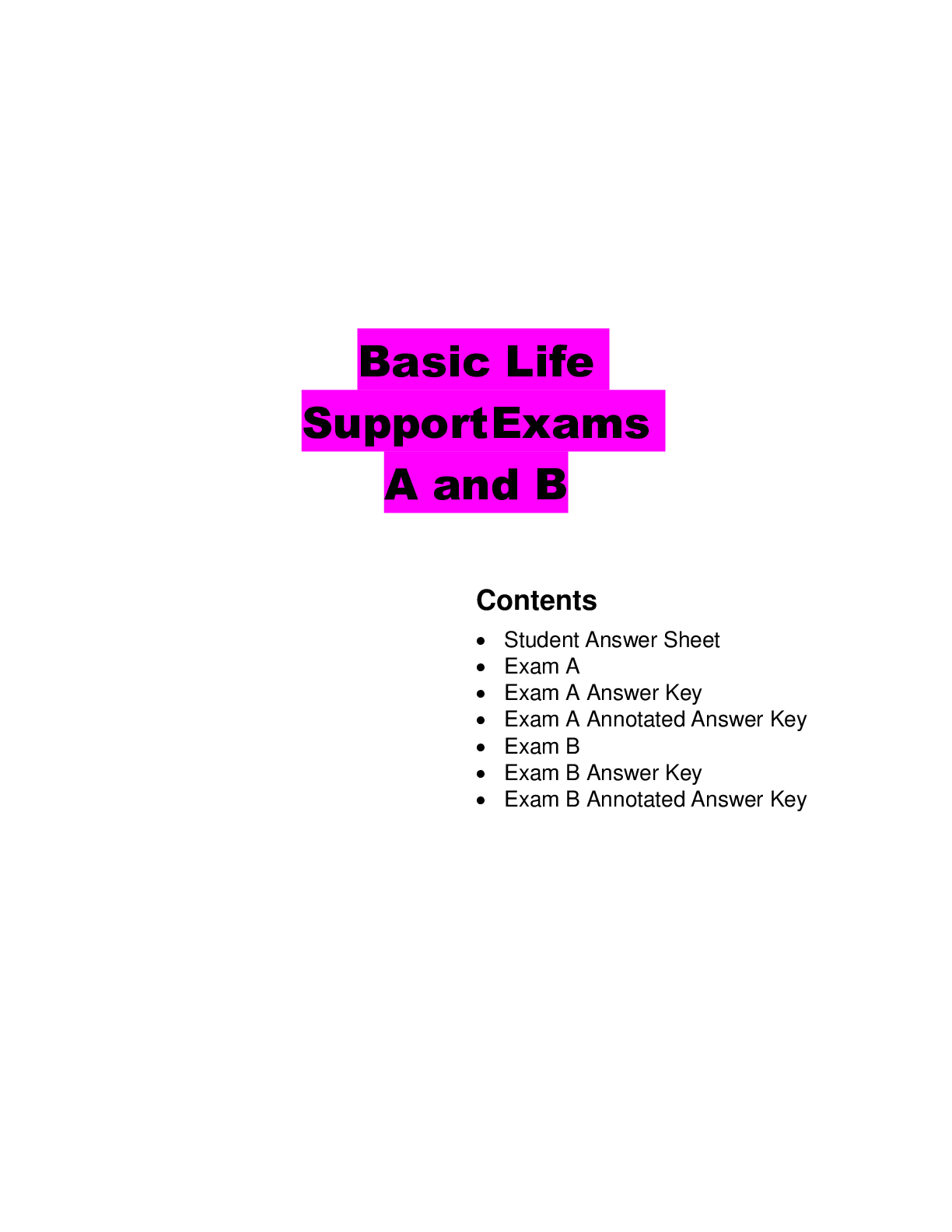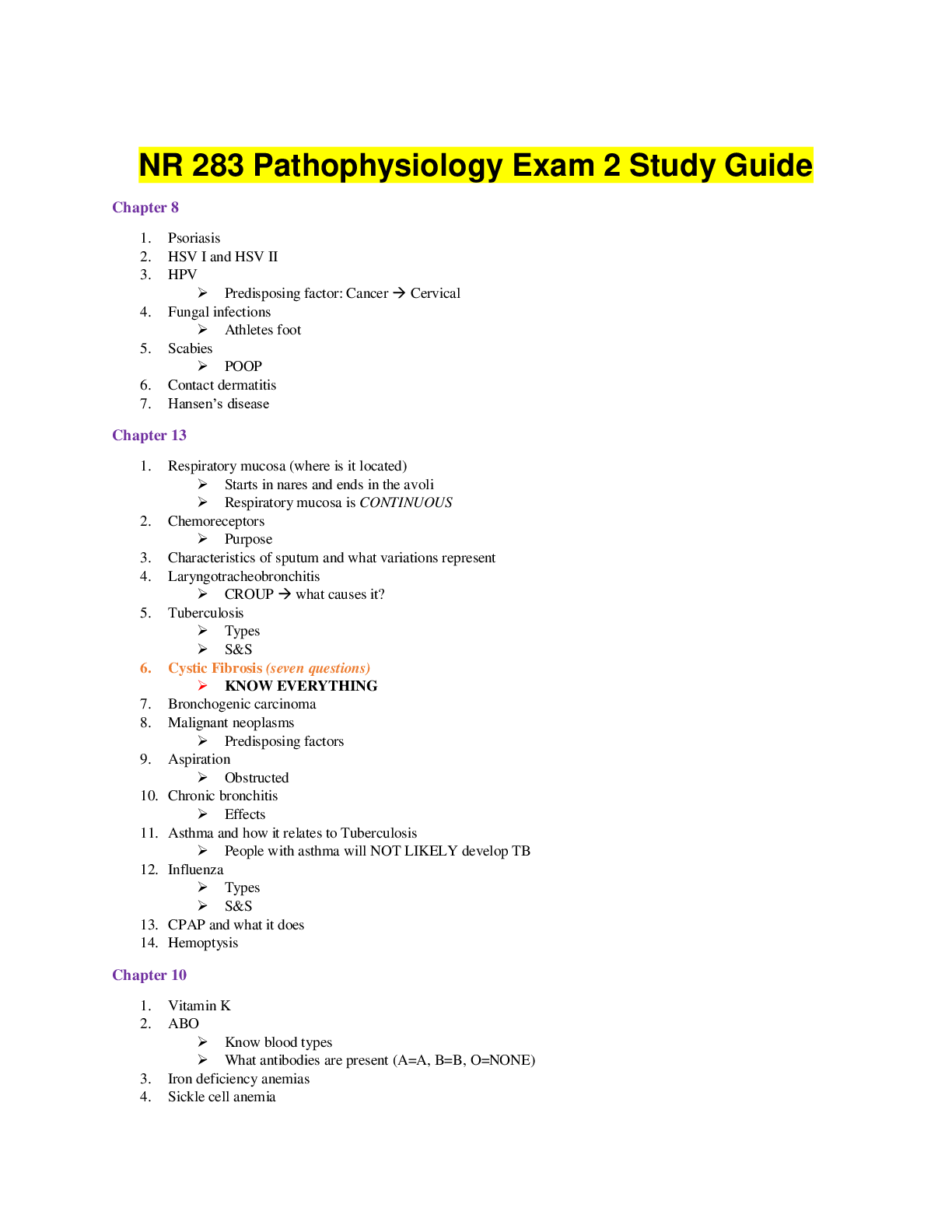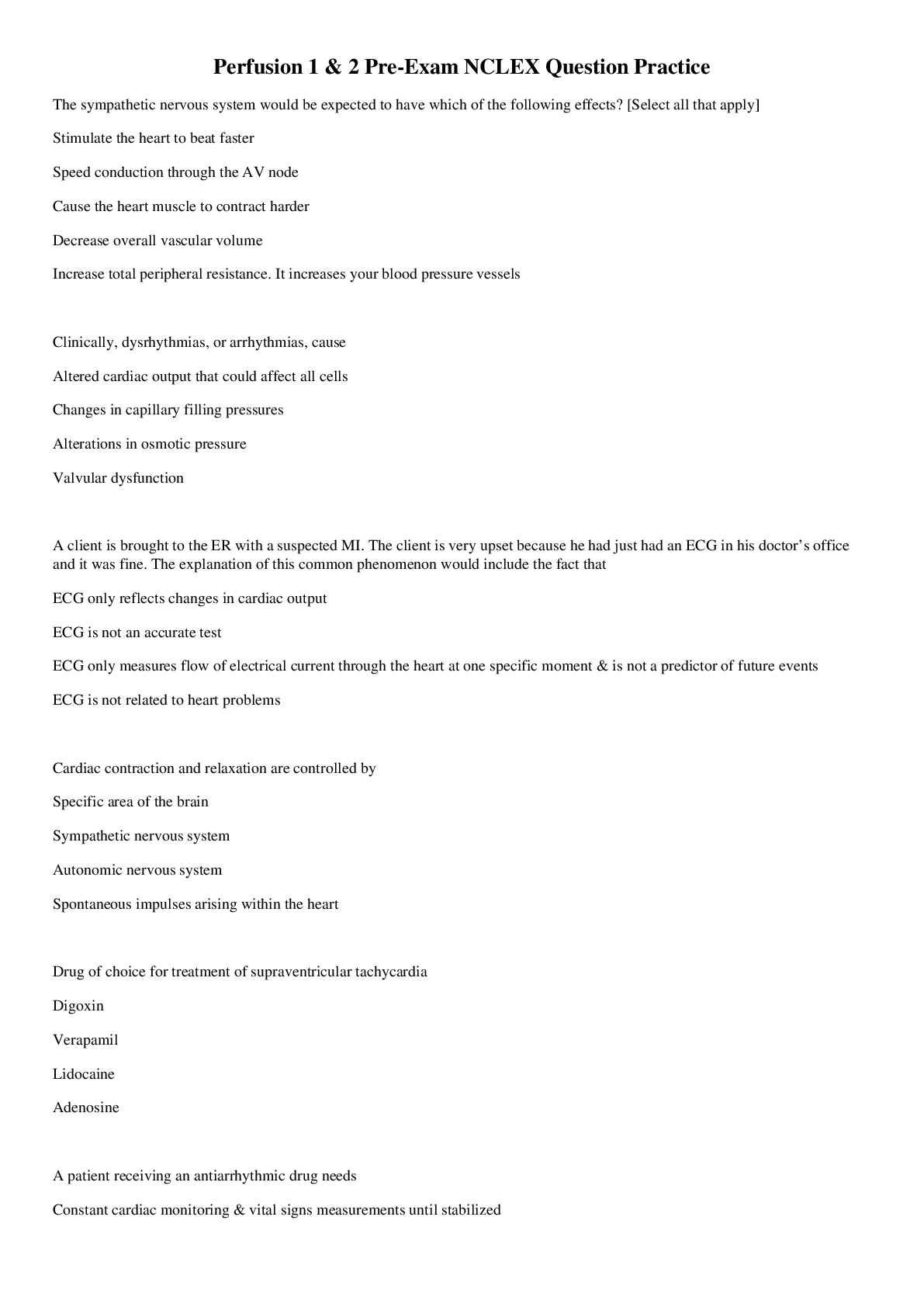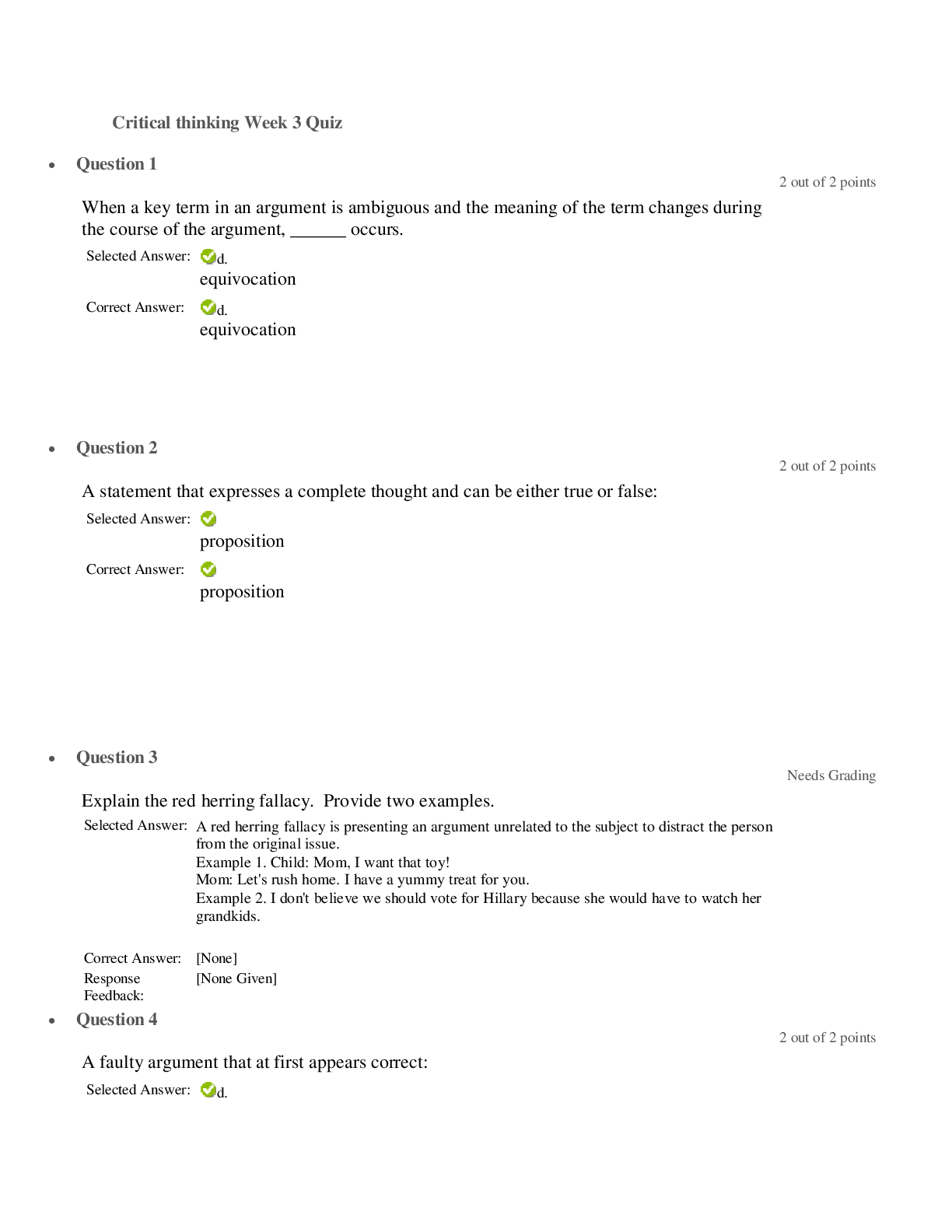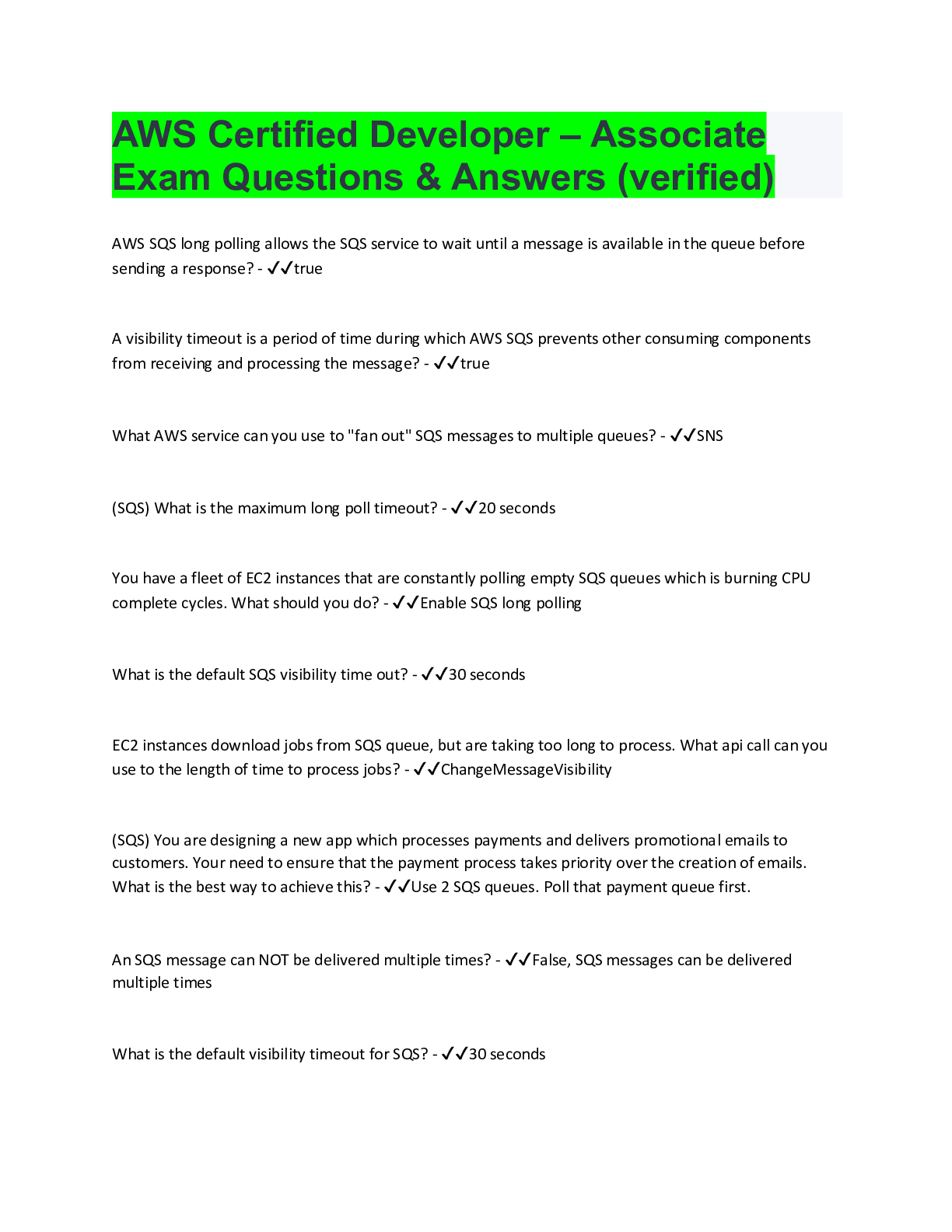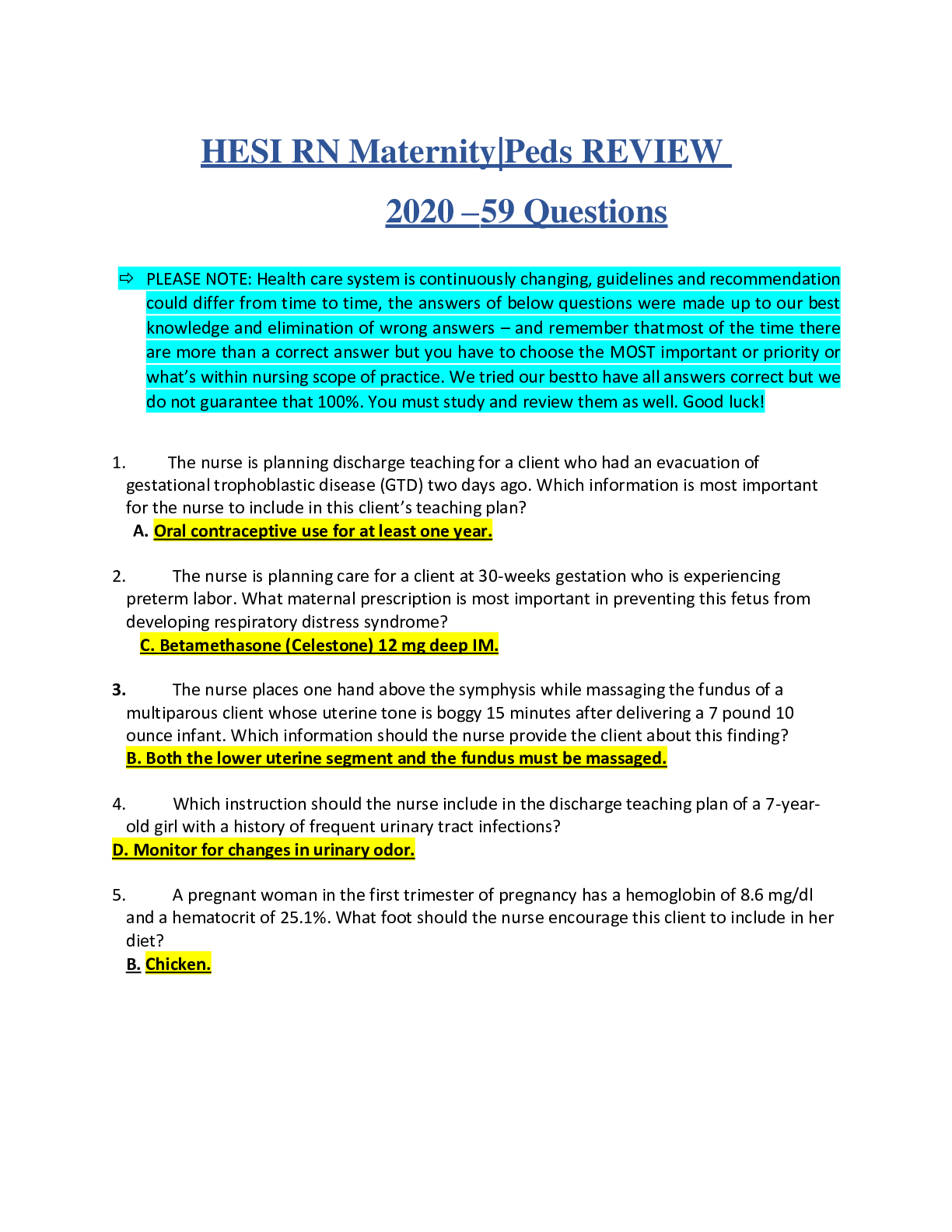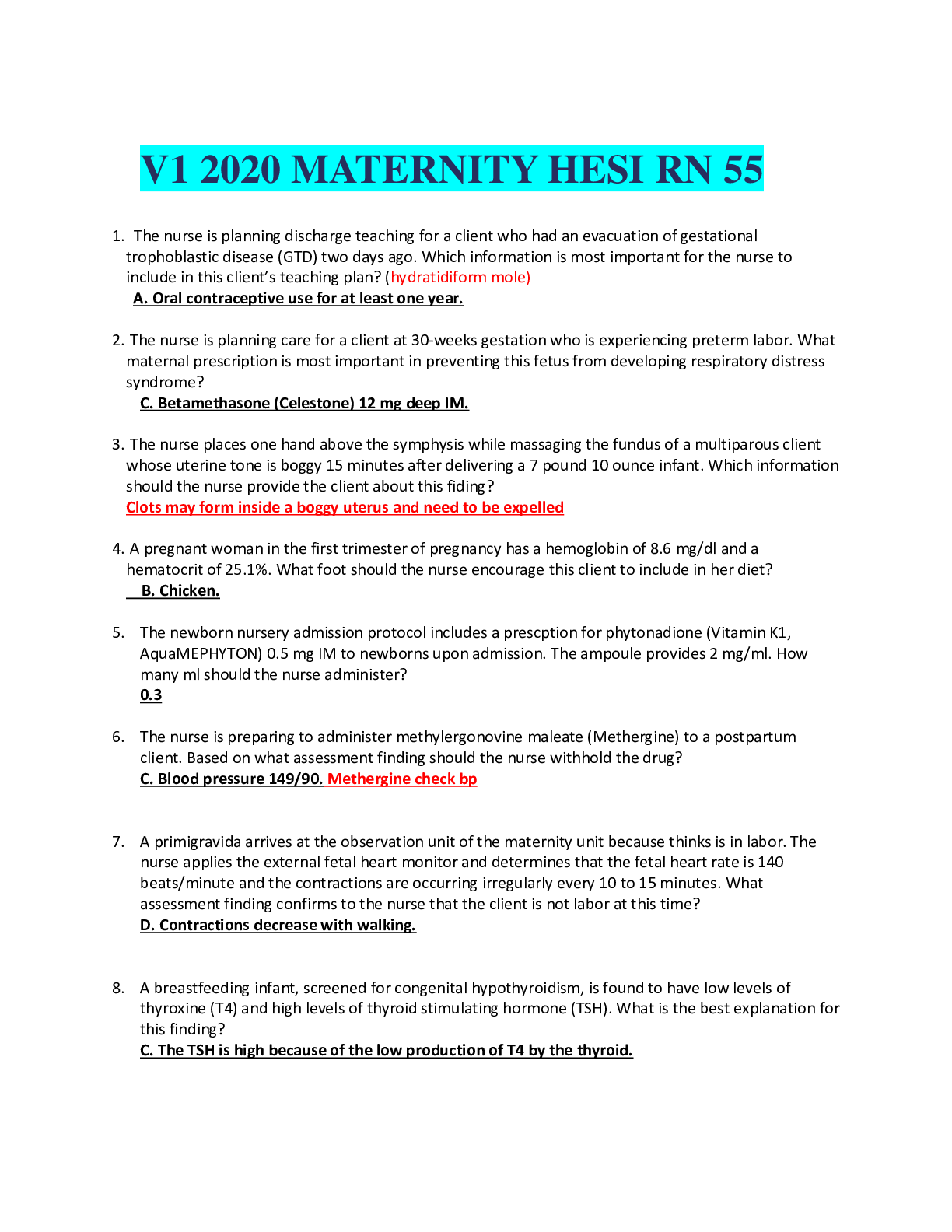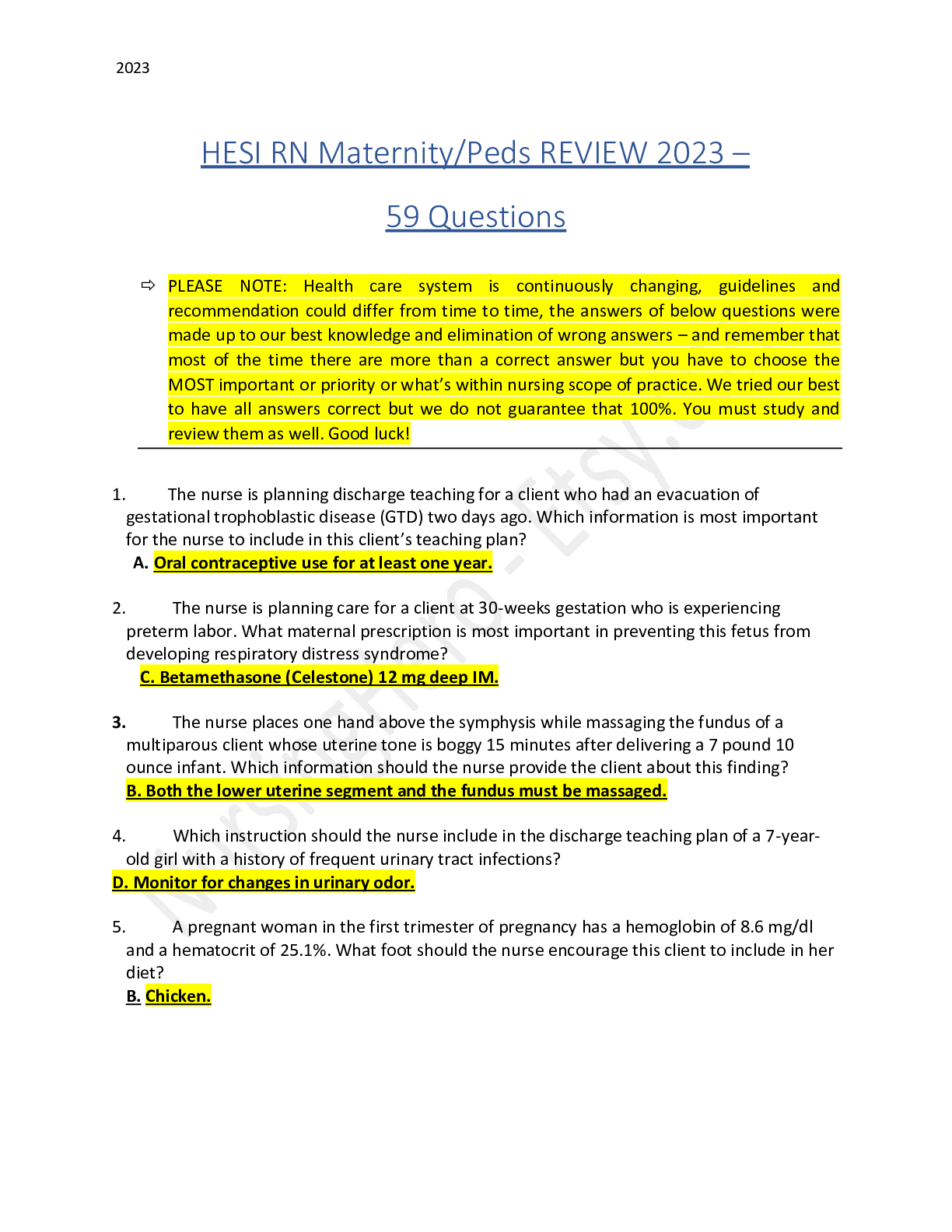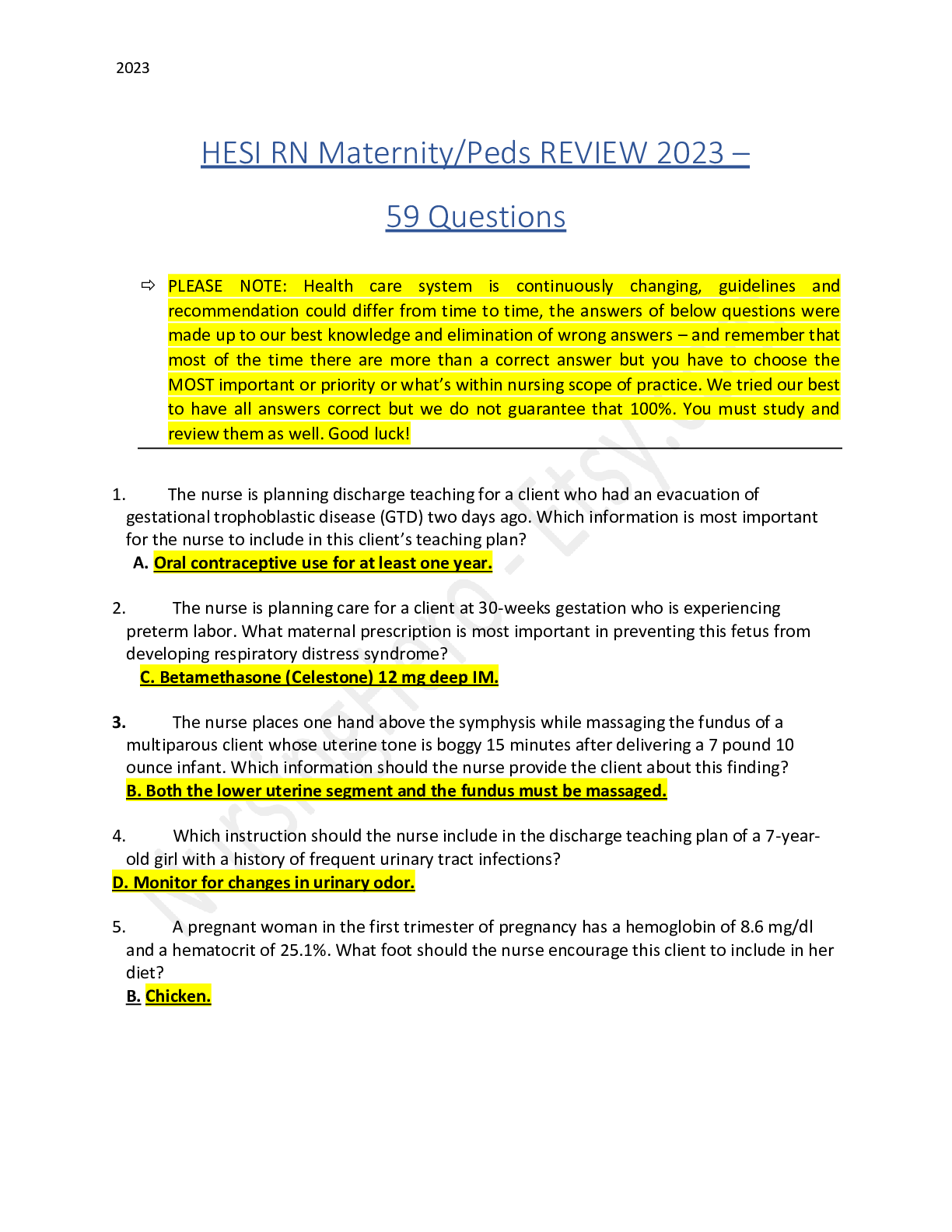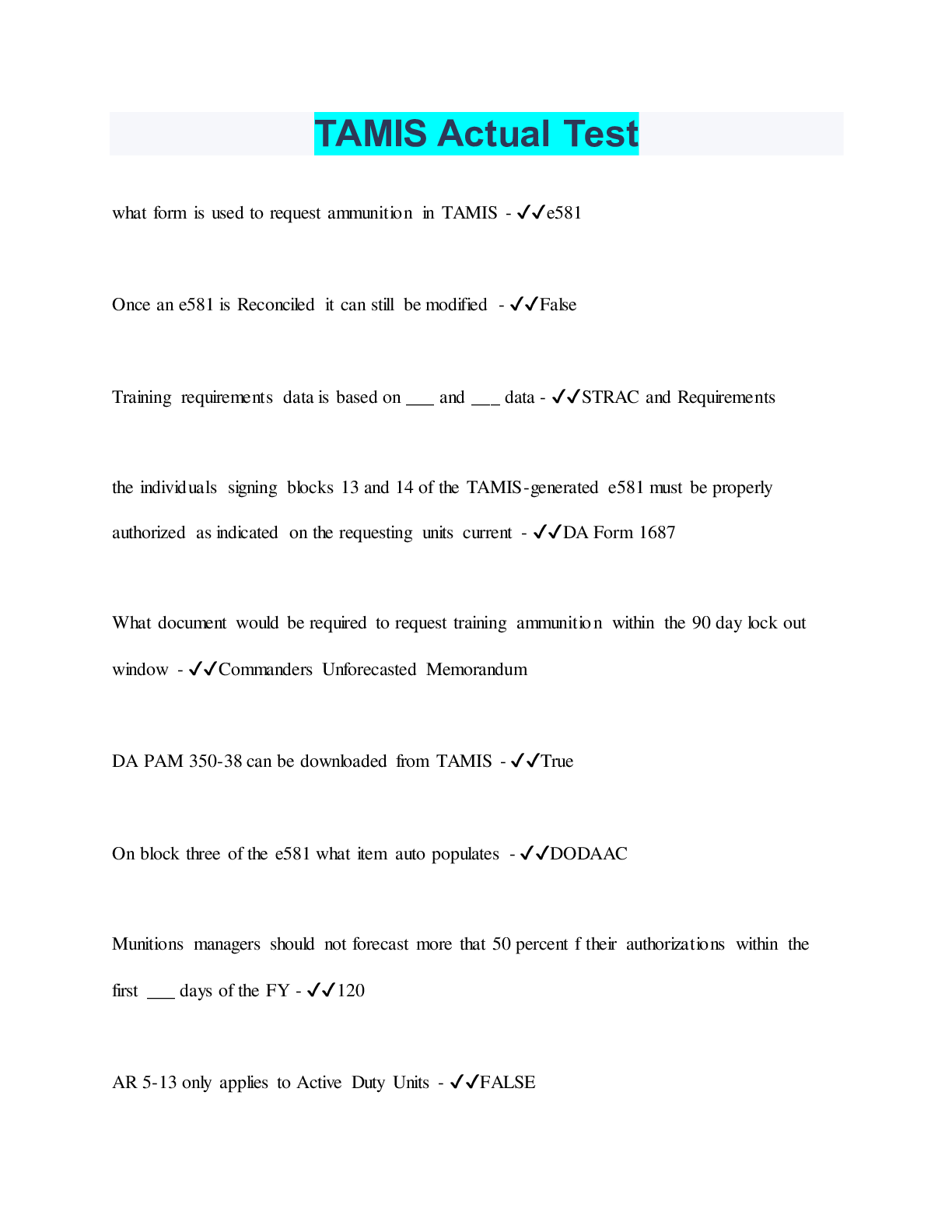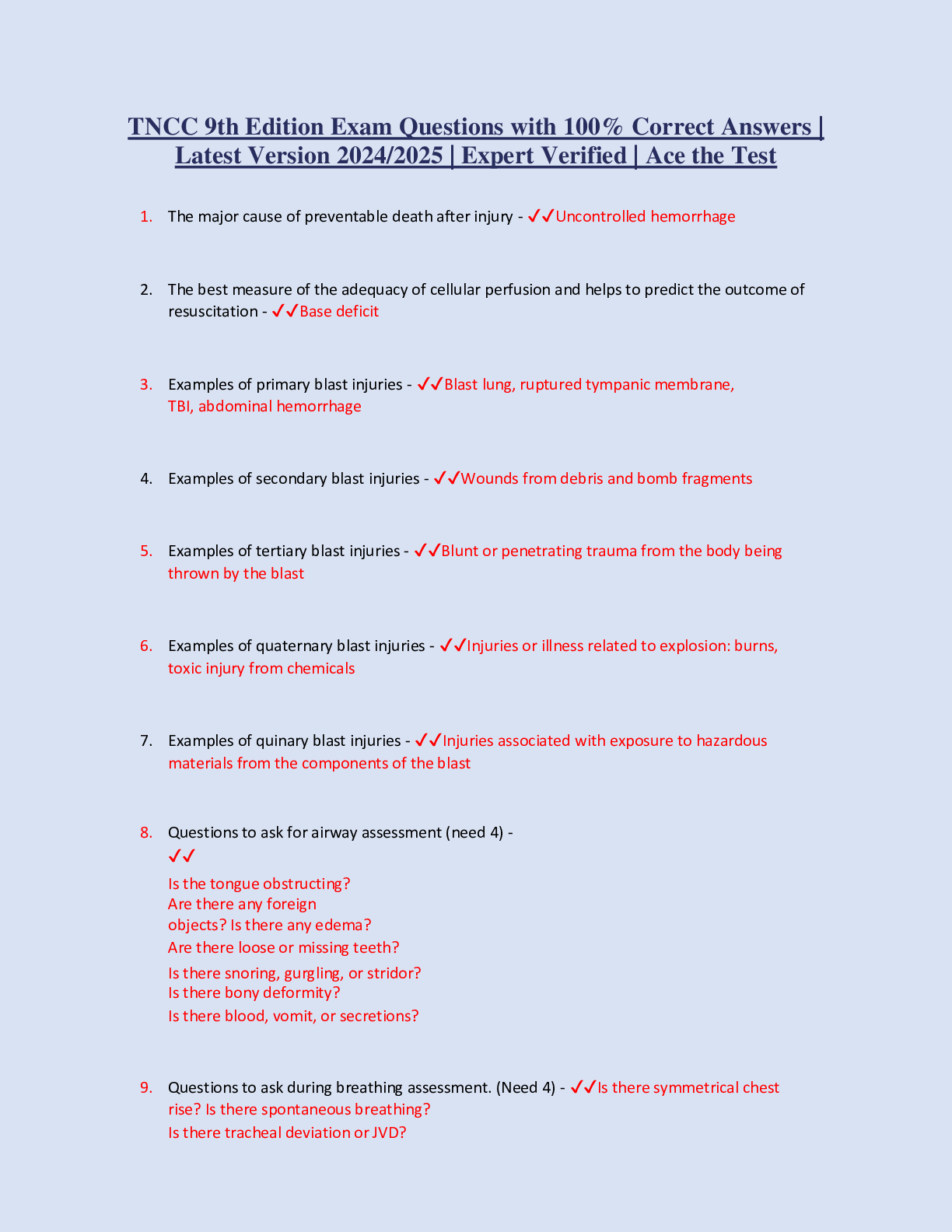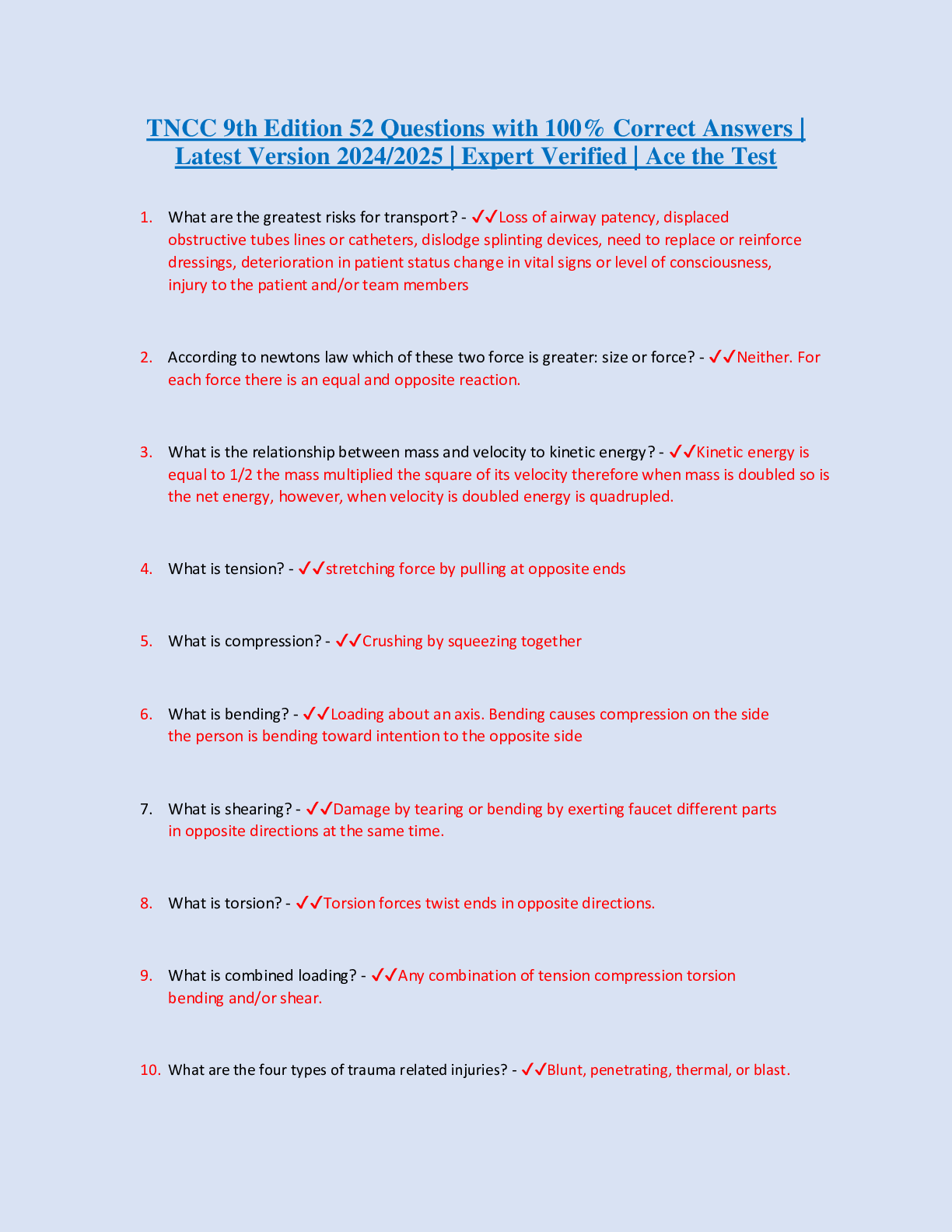V1 2023 MATERNITY HESI RN 55, Complete Questions & Answers (verified) .
Document Content and Description Below
V1 2020 MATERNITY HESI RN 55 The nurse is planning discharge teaching for a client who had an evacuation of gestational trophoblastic disease (GTD) two days ago. Which information is most important... for the nurse to include in this client’s teaching plan? (hydratidiform mole) 1. The nurse is planning care for a client at 30-weeks gestation who is experiencing preterm labor. What maternal prescription is most important in preventing this fetus from developing respiratory distress syndrome? 2. The nurse places one hand above the symphysis while massaging the fundus of a multiparous client whose uterine tone is boggy 15 minutes after delivering a 7 pound 10 ounce infant. Which information should the nurse provide the client about this fiding? 3. A pregnant woman in the first trimester of pregnancy has a hemoglobin of 8.6 mg/dl and a hematocrit of 25.1%. What foot should the nurse encourage this client to include in her diet? 4. The newborn nursery admission protocol includes a prescption for phytonadione (Vitamin K1, AquaMEPHYTON) 0.5 mg IM to newborns upon admission. The ampoule provides 2 mg/ml. How many ml should the nurse administer? 5. The nurse is preparing to administer methylergonovine maleate (Methergine) to a postpartum client. Based on what assessment finding should the nurse withhold the drug? 6. A primigravida arrives at the observation unit of the maternity unit because thinks is in labor. The nurse applies the external fetal heart monitor and determines that the fetal heart rate is 140 beats/minute and the contractions are occurring irregularly every 10 to 15 minutes. What assessment finding confirms to the nurse that the client is not labor at this time? 7. A breastfeeding infant, screened for congenital hypothyroidism, is found to have low levels of thyroxine (T4) and high levels of thyroid stimulating hormone (TSH). What is the best explanation for this finding? 8. A full-term, 24-hour-old infant in the nursery regurgitates and suddenly turns cyanotic. What should the nurse do first? 9. At 6-weeks gestation, the rubella titer of a client indicates she is non-immune. When is the best time to administer a rubella vaccine to this client? 10. A client is receiving oxytocin (Pitocin) to augment early labor. Which assessment is most important for the nurse to obtain each time the infusion rate is increased? 11. One day after vaginal delivery of a full-term baby, a postpartum client’s white blood cell count is 15,000/mm3. What action should the nurse take first? 12. A client delivers a viable infant, but begins to have excessive uncontrolled vaginal bleeding after the IV Pitocin is infused. When notifying the healthcare provider of the client’s condition, what information is most important for the nurse to provide? 13. A neonate who has congenital adrenal hyperplasia (CAH) presents with ambiguous genitalia. What is the primary nursing consideration when supporting the parents of a child with this anomaly? 14. During a 26-week gestation prenatal exam, a client reports occasional dizziness and lightheadness when she is lying down. What intervention is best for the nurse to recommend to this client. 15. The current vital signs for a primipara who delivered vaginally during the previous shift are: temperature 100.4 F, heart rate 58 beats/minute, respiratory rate 16 breaths/minute, and blood pressure 130/74. What action should the nurse implement? 16. A 4-day postpartum client calls the clinic and reports that her nipples are so sore that she does not know if she can continue to breastfeed her infant. What instruction is best for the nurse to provide? 17. A loading dose of terbutaline (Bretine) 250 mcg IV is prescribed for a client in preterm labor. Brethine 20 mg is added to 1000 ml D5W. How many ml of the solution should the nurse administer? (Enter numeric value only) 18. A newborn with myelomeningocele is admitted to the neonatal intensive care unit. Which preoperative nursing intervention should the nurse implement first? 19. An infant is placed in a radiant warmer immediately after birth. At one hour of age, the nurse finds the infant to be jittery, tachypneic, and hypotonic. What is the first action that the nurse should take? 20. The mother of a 5-week-old tells the nurse that her baby has acne and asks if she can use her teenage son’s acne cream, benzoyl peroxide, on the baby’s face. Which answer should the nurse to provide? 21. A 36-week primigravida is admitted to labor and delivery with severe abdominal pain and bright red vaginal bleeding. Her abdomen is rigid and tender to touch. The fetal heart rate (FHR) is 90 beats/minute, and the maternal heart rate is 120 beats/minute. What action should the nurse implement first? 22. A laboring client’s membranes rupture spontaneously. The nurse notices that the amniotic fluid is greenish-brown. What intervention should the nurse implement first? 23. A 34-week primigravida with pregnancy induced hypertension (PIH) is receiving Ringer’s Lactate 500 ml with magnesium sulfate 20 grams at the rate of 3 grams/hour. How many ml/hour should the nurse program the infusion pump? (Enter numeric value only) 24. The nurse weighs a 6-month-old infant during a well-baby check-up and determines that the baby’s weight has triple compared to the birth weight of 7 pounds 8 ounces. The mother asks if the baby is gaining enough weight. What response should the nurse offer? 25. Artificial rupture of the membranes of a laboring client reveals meconium-stained fluid. What intervention has the greatest priority? 26. A client whose labor is being augmented with an oxytocin (Pitocin) infusion requests an epidural for pain control. Findings of the last vaginal exam, performed 1 hour ago, were 3 cm cervical dilatation, 60% effacement, and a -2 station. What action should the nurse implement first? 27. A mother brings her 2-month-old to the well-baby clinic. She states that when she kisses her baby, the infant’s skin tastes salty. The nurse should prepare the mother for what standard diagnostic test to screen for cystic fibrosis (CF)? 28. A client with gestational diabetes is undergoing a non-stress test (NST) at 34-weeks gestation. The baseline fetal heart rate (FHR) is 144 beats/minute. The client is instructed to mark the fetal monitor paper by pressing a button attached to the fetal monitor each time the baby moves. After 20 minutes, the nurse evaluates the fetal monitor strip. Which outcome indicates a reactive NST? 29. A newborn who was a breech presentation is admitted to the nursery. Which assessment procedure is a priority for the nurse to perform? 30. The nurse is assessing a 38-week gestation newborn infant immediately following a vaginal birth. Which assessment finding best indicates that the infant is transitioning well to extrauterine life? 31. The nurse is measuring the frontal occipital circumference (FOC) of a 3-month-old infant, and notes that the FOC has increased 5 inches since birth and the child’s head appears large in relation to the body size. Which action is most important for the nurse to take next? 32. A 16-year-old gravida 1, para 0 client has just been admitted to the hospital with a diagnosis af eclampsia. She is not presently convulsing. Which intervention should the nurse plan to include in this client’s nursing care plan? 33. The nurse is caring for a one-year-old child following surgical correction of hypospadias. What nursing action has the highest priority? 34. What goal is most important for the nurse to include in the plan of care for a client with gestational diabetes? 35. A new mother is having trouble breastfeeding her newborn son. He is making frantic rooting motions and will not grasp the nipple. What intervention would be most helpful to this mother? 36. The nurse is interacting with a female client who is diagnosed with postpartum depression. Which finding should the nurse document as an objective signs of depression? (Select all that apply.) A. Avoids eye contact. B. Interacts with a flat affect. C. Reports feeling sad. D. Expresses suicidal thoughts. E. Has a disheveled appearance. [Show More]
Last updated: 1 year ago
Preview 1 out of 5 pages

Reviews( 0 )
Document information
Connected school, study & course
About the document
Uploaded On
Jun 29, 2020
Number of pages
5
Written in
Additional information
This document has been written for:
Uploaded
Jun 29, 2020
Downloads
0
Views
187

